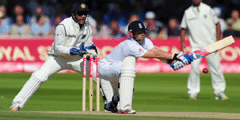What do football prices really mean? Former odds compiler and author of ‘Win At Fixed Odds Football Betting’ Malcolm Boyle shows you how to net the best value, without attracting penalties.
Each time you pick up a football coupon or log on to your internet account, you probably do so with confidence. When betting on football, it’s no wonder you fancy your chances – compared to a 30-runner handicap at Goodwood, football’s field of three is a doddle!
However, as you’re probably aware, the bookies do everything to shift the odds in their favour when it comes to pricing up a football match. To find a level playing field, you have to find out what the odds really mean.
Bookmaking is based on percentages, but punters should not be worried by the mathematics behind the odds. It really isn’t that difficult to determine that a price of 11/8 against equates to a bookmaker’s opinion that the team in question would potentially win eight matches from every 19 that they play against their given rivals at the given venue (don’t forget that home advantage plays a big part in the odds). Odds-on prices are equally simple to fathom – a team starting at 4/5 will, according to the bookmakers, win five out of every nine matches.
Essentially, you should NEVER have a bet unless you can determine the prices that you are willing to accept from your bookmaker. The easiest way for you to evaluate your own odds is to initially concentrate on the price for the draw between any two teams that you care to name.
Here comes the science bit
You can use scientific methods to calculate your own odds for the draw – you can look at the two teams’ previous results against each other and evaluate their form in the current season to work out how likely a draw is – or you can simply use your own feelings and hunches. If you’re betting late in the season, bear in mind that home and away wins become likelier at this time of year because teams are keener than ever to pick up points to make it to the play-offs, avoid relegation, and so on.
Once you have calculated your own price for a draw, you can compare them with the bookies’. The following odds are those laid by bookmakers for a match to end all-square, with the figures in brackets showing what percentage the price relates to in real terms:
21/10 (32.2%)
11/5 (31.2%)
9/4 (30.8%)
23/10 (30.3%)
12/5 (29.4%)
5/2 (28.6%)
13/5 (27.8%)
11/4 (26.7%)
3/1 (25.0%)
The Betrescue.com odds checker tool (see top navigation menu) contains a table showing the odds for each team (let’s say Bolton and Charlton for the sake of argument) to win, based on the price for the draw. So, if you believe that a match has around a 30 per cent chance of ending in a draw, simply find the correct prices from the table.
If you feel that Bolton and Charlton are 23/10 to fight out a draw (via your approximate 30% evaluation), you should now choose between the relevant prices for each team shown above.
If you believe that one of the teams is a hot favourite to win, you might select Bolton as 8/13 to win the match (your belief being they would win 13 out of every 21 matches between the sides at home), which leaves Charlton as a 4/1 chance. If the match is more even in your opinion, you might bet on Bolton at 6/5 (thereby estimating they would win five out of every 11 games) and Charlton at 17/10 (ten from every 27 matches).
This method is the best way for you to understand the prices set by the bookie and see whether they really represent value. Once you have evaluated your own views in the same language – expressed as odds – you will see whether or not the prices are really worth taking.
Be Wary of Bookies’ Traps
The most popular form of betting, outside of the basic method of backing teams to win, is the correct score sector of the market. If you read the forums, you’ll have learned about the mathematical method behind correct score betting, but unless you apply the rules of science, correct score betting is not worth the bother – the percentages are heavily stacked in favour of the bookmaker.
Taking into account that the bookmakers have already added their potential ‘profit’ into the original price, you should be disgusted to learn that anything up to another 30 per cent is added to the ‘mark up’ via correct score betting. A coupon I picked up at random from a leading bookie turned a 5/2 chance in win terms into 2/1, via correct score odds. And that only accounted for six potential winning scorelines! The potential added profit for the bookmaker is 16.4% without any other ‘correct score’ that might come into play!
A team starting at 6/4 potentially yields an additional 19.2% via nine potential scorelines, turning the 40% price into an 11/10 chance. It gets even worse when you study the figures for a team priced up at 1/2. A whopping 25.7% is potentially added to the bookmaker’s satchels as the first 11 betting opportunities evaluate to 1/5! The majority of punters back favourites by definition; hence they are being fleeced beyond comprehension, which is exactly why I’m suggesting that you steer clear of correct score betting.
Betting on the first/last goalscorer is another wager that was invented by the bookmaker, for the bookmaker. Football is a game with 20 outfield players and a maximum of two of them in any given game – the first and last goalscorer – force the bookies to pay out on this particular market, so it is a guaranteed money-spinner for the bookie. Long lists, short lists and handicap lists (in particular) are designed to rid you of as much money as the bookmaker is legally allowed to take!
I’ll admit to being sucked into having bets on the half time/full time markets – this is where you bet on what the state of play will be at half-time (Team A ahead, Team B ahead or a draw) and what the final outcome of the match will be – but that is because I am a ‘trend-and-stats man’ at heart. There is at least a certain logic to the half-time/full-time wager, because of the way that managers ask their teams to perform from week to week. For example, it is possible to predict the way a team approaches a game: will they play to win or pick up a draw? Does the manager send them out to play attacking football? This gives you added value that you simply cannot have when betting on a first goalscorer, as all sorts of players, particularly at corners and free kicks, can score goals. The half-time/full-time wager also allows you to re-evaluate your bet at the half-way stage, and you can place another bet on the outcome of the match after 45 minutes, possibly looking to create a ‘no lose’ scenario on the eventual result. There are some ways of finding the value – but you have to understand the odds first.










